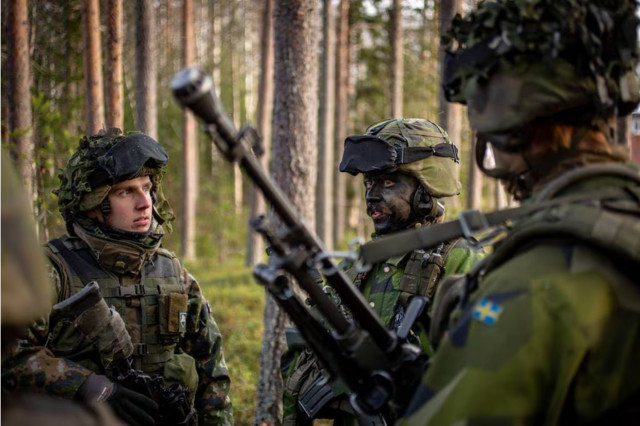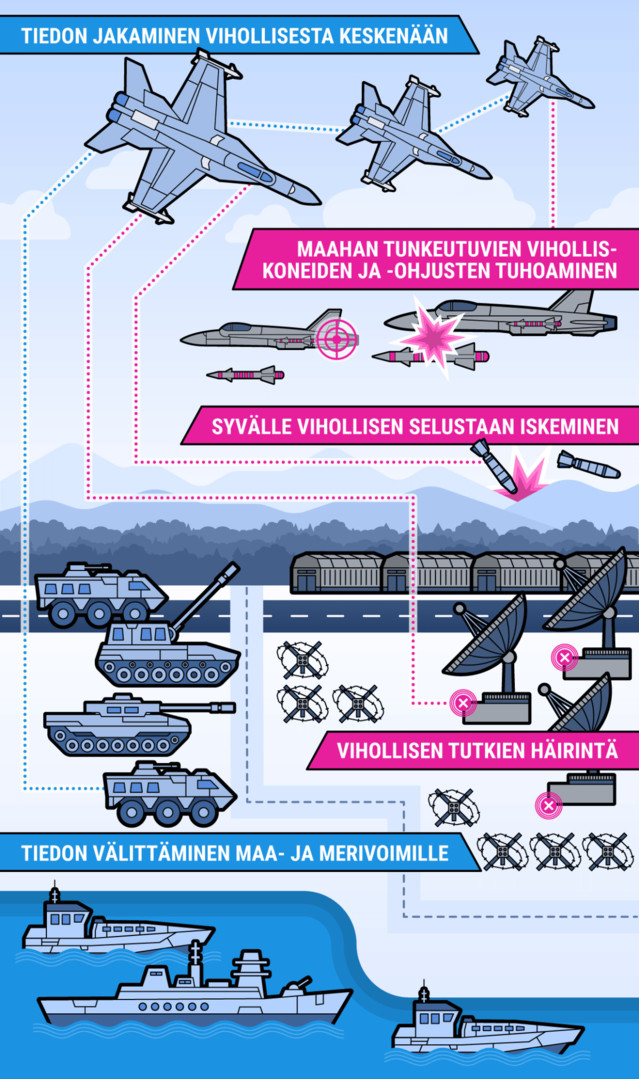Senior Editor
Military Embedded Systems

Developing artificial intelligence (AI) technology for the battlefield is a top priority for the U.S. Department of Defense (DoD) as its adversaries continue to scale up their own AI and machine learning capabilities. Much of the DoD’s AI wizardry is spun out of the U.S. Defense Advanced Research Projects Agency (DARPA), which looks to enable machines to become trusted, collaborative partners of not just warfighters but all humans.
Much like they have driven the increased emphasis on cybersecurity, trusted computing, and microelectronics, the U.S. government and the U.S. Department of Defense (DoD) are making dominance in artificial intelligence (AI) and machine learning (ML) technology essential across all domains.
The pressure is on: Earlier in 2021, the National Security Commission on Artificial Intelli-gence (NSCAI) submitted its Final Report to Congress and the President, outlining a need for the DoD to be AI-ready by 2025. The NSCAI report defines “AI-ready” as “Warfighters enabled with baseline digital literacy and access to the digital infrastructure and software required for ubiquitous AI integration in training, exercises, and operations.” [Note: this report can be found at https://reports.nscai.gov/final-report/table-of-contents/]
“Even with the right AI-ready technology foundations in place,the U.S.military will still be at a battlefield disadvantage if it fails to adopt the right concepts and operations to integrate AI technologies,” the report continues. “Throughout history, the best adopters and integra-tors, rather than the best technologists, have reaped the military rewards of new technolo-gy. The DoD should not be a witness to the AI revolution in military affairs, but should deli-ver it with leadership from the top,new operating concepts,relentless experimentation, and a system that rewards agility and risk.”
It’s important to realize “you can’t just flip a switch and have these capabilities in place,” according to NSCAI Commissioners Andy Jassy and Ken Ford.“It takes steady, committed work over a long period of time to bring these capabilities to fruition.”
The report says “the DoD must act now to integrate AI into critical functions, existing sys-tems, exercises, and wargames to become an AI-ready force by 2025.” To get there, the report recommends the U.S. government responsibly develop and use AI technologies, with an emphasis on implications and applications of AI for defense and national security.
Hardware will play a key role.The report notes that due to China’s conflict with Taiwan, the U.S. is dangerously close to losing access to the vast majority of cutting-edge microelect-ronics (fabricated in Taiwan) that power U.S.companies and military.It recommends revita- lizing our domestic semiconductor design and manufacturing to ensure that the U.S. is two generations ahead of its adversaries. (See more on this in our Editor’s Perspective on page 5.)
The report also stresses the importance of innovation: “The U.S. needs to sustain and increase investment in AI research to set conditions for accessible domestic AI innovation and drive the breakthroughs to win the technology competition through establishing a national AI research infrastructure and doubling Federal investments in AI R&D to reach $32B by 2026.”
AI R&D starts with DARPA
Military AI research actually began literal decades ago. A few examples: In the 1960s, the DoD began training computers to mimic basic human reasoning. By the 1990s, work on machine learning (ML) advanced from knowledge-driven to data-driven approaches, and computer programs were created to analyze vast amounts of data and “learn” from the results. Deep learning, which uses algorithms to let computers recognize objects and text within images and videos, advanced in the 2000s and 2010s. Computer vision, a combi-nation of ML and neural networks, now can autonomously find objects of interest within video and imagery from drones within war zones. [Note: For more on AI/ML history, read https://militaryembedded.com/ai/machine-learning/artificial-intelligence-timeline]
“Our vision for AI today is the same as it was at the very beginning: to enable machines as trusted, collaborative partners to help humans solve important national-security problems,” says Valerie Browning, director of the Defense Advanced Research Projects Agency (DARPA) Defense Sciences Office.
AI is already providing value to humans for tasks in which decisions about how to execute a task are either governed by a limited set of well-understood rules or can be based on statistical pattern recognition, she says; this value will continue to increase.
“But AI that can be trusted to augment and support humans in a broader range of real-world, time-critical tasks within dynamic and unknown environments – as is often the case for military applications – remains an aspirational goal for DARPA,” Browning notes.“As far as we’ve come, we have that much further and more to go to achieve the original DARPA AI vision of truly symbiotic, trusted collaborative partnerships between humans and machines.”
Enabling AI within military systems
There are challenges involved with using AI within the military and its systems, with the biggest one that “the military operational environment can be very dynamic and is often unknown,” says Browning. “This creates challenges in acquiring and making available the copious amount of data needed to train today’s state-of-the-art AI systems.”
Even when it is possible to train an AI system to perform a particular task, “adapting it to a new task or environment is typically not possible without significant retraining that may or may not preserve the competency of the system for prior learned tasks,” she adds.
Current AI systems “work well in applications where the consequences of ‘getting it wrong’ are tolerable and noncatastrophic,” Browning points out. “The increasing complexity and speed of military operations places a high bar for AI systems that support ‘faster-than-thought’ decision-making in situations where human lives are at risk. And realistic test and evaluation of AI systems in terms of how they will perform in these types of applications is extremely difficult.”
Military use of AI
AI is currently being used for military applications such as language translation, image classification, medical diagnosis, cyber defense, and automation of critical business processes including software accreditation and security clearance vetting.
“We have a clear understanding of the limitations of current state-of-the-art AI based on machine learning, so we can reasonably predict the type of applications that can benefit from near-term AI. In the longer term, as the original DARPA vision of truly trusted and collaborative human-machine partnerships come to fruition, we can expect to see AI in-creasingly deployed to support time-critical decision-making within tactical environments,” Browning says.
Explainable AI
One challenge to adopting AI for military applications is that users want to understand how it reaches a conclusion.
“DARPA’s Explainable AI (XAI) program has made significant advancements toward AI algorithms that are more transparent and understandable to a broad range of users,” says Matt Turek, a program manager in DARPA’s Information Innovation Office. “We’ve created new XAI techniques that allow AI developers to better introspect and understand machine-learning models during the development process.”
XAI has also built new approaches for explaining decisions to operational users, Turek adds, like highlighting the region of an image that most influenced a decision. “We’ve de-veloped processes for explaining AI systems to commanders, such as a new after-action review process for AI that uncovers key decision points for an autonomous system after a mission,” he adds.
Real-time conversational AI for robots
Speaking is the most natural way for people to interact with complex autonomous agents or robots. Knowing this, researchers from the U.S.Army Combat Capabilities Development Command (DEVCOM), Army Research Laboratory and the University of Southern Califor-nia’s Institute for Creative Technologies devised a way to flexibly interpret and respond to soldier intent derived from spoken dialogue with autonomous systems.
The lab’s joint Understanding and Dialogue Interface (jUDI) system relies on a statistical classification technique to enable conversational AI via state-of-the-art natural-language understanding and dialogue-management technologies.
“The statistical language classifier enables autonomous systems to interpret the intent of a soldier by recognizing the purpose of the communication and performing actions to realize the underlying intent,” explains Army researcher Felix Gervits. “For example, if a robot re-ceives a command to turn 45 degrees and send a picture, it could interpret the instruction and carry out the task.”
The classifier is trained on a labeled data set of human-robot dialogue generated during a collaborative search-and-rescue task. It learned “a mapping” of verbal commands to res-ponses and actions - allowing it to apply this knowledge to new commands and to respond in an appropriate manner. (Figure 1.)

[Figure 1 | Army researchers create a novel approach to allow autonomous systems to interpret and respond to soldiers.Image courtesy U.S. Army/1st Lt. Angelo Mejia.]
The researchers say that the technique can be applied to combat vehicles and autono-mous systems to enable advanced real-time conversational capability for soldier-agent teaming. “By creating a natural speech interface to these complex autonomous systems, researchers can support hands-free operation to improve situational awareness and give our soldiers the decisive edge,” Gervits says.
Interacting with conversational agents requires little to no training for soldiers. “There is no requirement to change what they would say,” he adds. “A key benefit is the system also excels at handling noisy speech, which includes pauses, fillers, and disfluencies – all features one would expect in a normal conversation with humans.”
The classifier is trained ahead of time, so it can operate in real time without processing delays in conversation. This technique supports increased naturalness and flexibility in soldier-agent dialogue and can improve the effectiveness of these kinds of mixed-agent teams, Gervits says.
AI-enabled malign information campaigns an emerging, morphing challenge
A different form of AI weaponry is emerging in the form of the insidious spread of disinfor-mation campaigns on social media, which can be shockingly effective on a targeted and massive scale.
The NSCAI report warns: “The prospect of adversaries using machine learning, planning, and optimization to create systems to manipulate citizens’ beliefs and behavior in undetec-table ways is a gathering storm. Most concerning is the prospect that adversaries will use AI to create weapons of mass influence to use as leverage during future wars, in which every citizen and organization becomes a potential target.”
One of the report’s recommendations is to fund DARPA to coordinate multiple research programs to detect, attribute, and disrupt AI-enabled malign information campaigns and to authenticate the provenance of digital media. This approach would “amplify ongoing DARPA research programs to detect synthetic media and expand its efforts into attributing and disrupting malign information campaigns,” the report states.
DARPA is exploring how to combat these threats through its “Media Forensics (MediFor) program-developed tools that automatically produce a quantitative integrity score indica-ting if an image or video was manipulated or AI-generated,” Turek says. “MediFor techno-logy is foundational for detecting deep fakes and other forms of AI-manipulated media.”
For its part, DARPA’s Semantic Forensics (SemaFor) program is building tools to detect, attribute,and characterize falsified text,images, audio, and video. DARPA’s Influence Cam- paign Awareness and Sensemaking (INCAS) will develop techniques to help analysts de-tect, characterize, and track geopolitical influence campaigns with quantified confidence. The SemaFor program launches later in 2021.
***
https://www.iltalehti.fi/politiikka/a/934fc775-cecd-431b-ab16-d939c4b28217
" IL Washingtonissa: Soini on vakuuttunut, että pääsisi eduskuntaan - ”Muu optio on sitten mennyt”
Siniset julkistivat perjantaina vaaliohjelmansa, jossa vaaditaan muun muassa sataa uutta hävittäjää. "Mainio puolustusministerimme on sanonut, että jos meillä on sata hävittäjää, silloin 64 hävittäjää on käytettävissä eikä parhaillaan huollettavana", Soini perustelee vaatimusta HELLEVI MAUNO
perjantai 8.2.2019 klo 20:11
Yhdysvaltain pääkaupungissa Washingtonissa vieraileva ulkoministeri Timo Soini (sin) kertoo, että “lähes kaikki” ovat tiedustelleet häneltä Amerikan-vierailun aikana, aikooko hän asettua ehdolle kevään eduskuntavaaleissa.
– Järki sanoo, että lopeta ja tee jotain muuta, mutta tunne on hyvin vahva, että mitä Suomen politiikka on ilman Timo Soinia. Ja toisaalta mitä minä olisin ilman politiikkaa, ulkoministeri hymistelee.
– Uskon, että eduskuntaan pääsen, jos asetun ehdolle, mutta muu optio on sitten mennyt. Paine on kova ja tulee paljon viestiä, että astu ehdolle. Mutta tulee myös viestiä, että ajattele itseäsi. Keskustelen asiasta vaimon kanssa, hän on ainut ulkopuolinen ihminen, joka voi vaikuttaa päätökseeni, hän jatkaa.
Soini kertoo, että ehdoton takaraja päätöksen tekemiselle on maaliskuun viides päivä.
Ei hävittäjähuutokaupoille
Siniset julkistivat perjantaina vaaliohjelmansa, jossa vaaditaan muun muassa sataa uutta hävittäjää aiemmin kaavaillun 64 hävittäjän sijaan.
Ulkoministeri kertoo luottavansa puolustusvoimien ja puolustusministeri Jussi Niinistön (sin) arvioon.
– Toivoisin, ettei hävittäjistä tule huutokauppaa vaalien alla. Joku huutaa yhden luvun, ja joku toisen. Toivon, ettei keskustelussa mennä siihen, että otan neljä hävittäjää pois ja laitan rahat vanhustenhuoltoon. Luotan siihen, että puolustusvoimat tietää, Soini kommentoi Iltalehden kysymystä hävittäjistä.
– Jos meillä on sata hävittäjää, silloin 64 niistä on käytössä eikä huollossa, hän perustelee vaatimusta.
Rukousaamiainen

Ulkoministeri Timo Soini (sin) tapasi Washingtonin-vierailullaan muun muassa Yhdysvaltain kansallisen turvallisuusneuvonantajan John Boltonin. Kaksikko keskusteli Nato-yhteistyön tärkeydestä ja Afganistanin tilanteesta. "On tärkeää, että Yhdysvaltain liittolaiset tietävät, mitä suunnitellaan", Soini kommentoi. Riikka Taivassalo / ulkoministeriö
Soini osallistui vierailullaan vuosittain järjestettävälle Kansalliselle rukousaamiaiselle ja kertoo istuneensa samassa pöydässä kahden georgialaisen republikaanisenaattorin kanssa.
– Suomessa ja Euroopassa ei aina oikein käsitetä, miten homma toimii. Hillille (Capitol Hillille) ei vain kävellä. Jos olet tuollaisella aamiaisella pari tuntia samassa pöydässä, pystyt luomaan kontaktin ja järjestämään tapaamisen. Missään ei tapaa yhtä hyvin sekä demokraatteja että republikaaneja, ja muita bisnespuolen uskonnollisia johtajia. Täällä saa olla mitä mieltä vaan, eikä kukaan sitä ihmettele, Soini kiittelee.
Ministeri kertoo myös Yhdysvaltain hallinnon sulun puhuttaneen. Hän kertoo tavanneensa paljon ihmisiä, jotka ovat sanoneet hallinnon työntekijöiden tekevän melko lyhyttä työpäivää, “joten olkoot kiinni”.
– Ei tällaista ajattelua tapaa paljon Suomessa.
Raadollinen totuus
Lisäksi Soini tapasi Washingtonin-vierailullaan Yhdysvaltain kansallisen turvallisuusneuvonantajan John Boltonin. Kaksikko keskusteli Nato-yhteistyön tärkeydestä ja Afganistanin tilanteesta.
– Puhuimme Irakista, Nato-yhteistyön tärkeydestä, Afganistanista ja siitä, kuinka tärkeää on, että Yhdysvaltain liittolaiset tietävät, mitä suunnitellaan ja missä mennään. Yhdysvallat ei ole sanonut, että joukot lähtevät kokonaan Afganistanista, vaan että maa vähentää joukkojen määrää. Suomen ja Euroopan kannalta on tärkeää, että riittävä läsnäolo säilyy, Soini sanoo.
– Afganistanin tilanne on kestänyt kohta 20 vuotta. Jotain ratkaisua tähän halutaan, mutta äkkiliikkeet eivät ole hyvästä, hän jatkaa.
Ministeri kertoo huomanneensa vierailunsa aikana, kuinka poliittinen tilanne ja politiikan realiteetti on ylipäänsä muuttunut.
– Se on amerikkalaisten asia, ketä he äänestävät, mutta näen tämän isona kuviona, kuinka politiikan peli muuttuu. Trump (Donald Trump) ei olisi ikinä voinut voittaa vaaleja, jos olisi toiminut perinteisen median ja demokratian keinoin. Luulen, että tällainen politiikan tekemisen malli voi levitä Eurooppaankin. Raadollinen poliittinen totuus on se, että vaaleissa päätetään siitä, mitkä ovat voimasuhteet eikä siitä, kuka on oikeassa ja kuka väärässä".
https://www.iltalehti.fi/politiikka/a/61d5dbb9-61ab-4119-94f7-757d8a843a7f "
https://www.is.fi/ulkomaat/art-2000005993596.html
***
https://www.defensenews.com/smr/nato-2020-defined/2019/12/17/finlands-defense-minister-antti-kaikkonen-on-ai-and-new-fighter-jets/
" NATO 2020 Defined
Finland’s Defense Minister Antti Kaikkonen on AI and new fighter jets
By Aaron Mehta
Dec 17, 2019

A Finnish soldier talks to Swedish soldiers during the NATO-led exercise Trident Juncture in 2018. (Marcus Nilsson/Swedish Armed Forces)
As a nonaligned NATO partner that shares roughly 830 miles of border with Russia, Finland is keenly aware of the need to keep its national defense in top shape. It also has held the rotating presidency of the European Union for the last six months, with a focus on security issues, including artificial intelligence.
During a recent visit to Washington — his first to America since taking over as Finnish defense minister — Antti Kaikkonen talked with Defense News about keeping Finland in the know on cutting-edge military technology.
Finland has used the EU presidency to host discussions on artificial intelligence development, both technically and ethically. How important is AI for the Finnish Ministry of Defence?
First of all, it’s something that is still more or less rising on our agenda, an issue for the whole of Europe, the whole world as well. We have to put focus on these issues, and perhaps discuss the ethics of AI, for example, some kind of regulation in this area.
These are not simple questions at all but something that should be discussed and try to find a common consensus. We are putting quite a lot of resources to cyber, and I see AI as part of cyber. We are hiring about 200 experts in cyber in the near future. Some of them are already there, but [it’s] about that [number].
How do you balance traditional defense investments with new technologies?
This is always something that’s difficult to separate, [saying] these are high-tech, cyber, these are traditional, where we invest. We invest [a lot] on new fighters, they are quite high-tech. We have quite strong artillery as well, and when upgrading this it is also a question of high tech. This cyber program we have will invest about 200 personnel and about €200 million (U.S. $222 million) for this, so a rather big investment for us. Of course, we try to use our monies wisely.
U.S. Defense Secretary Mark Esper, center, welcomes Finnish Defence Minister Antti Kaikkonen, right, and Swedish Defence Minister Peter Hultqvist at the Pentagon on Dec. 10, 2019. (Olivier Douliery/AFP via Getty Images)
A decision on your next-generation fighter is expected in 2021. The government recently emphasized to industry that the budget targets are actually harder budget requirements. What was the thinking there?
That was the plan from the beginning, to work on this process like this so everybody knows approximately how much we are ready to invest. And we’ll see what kind of package we get from each of these fighter producers. It’s not only the planes, it’s the whole system which will be included here, and then we are going to [be] deliberate: Which is the best offer for us for this price? They have different packages and systems. We have 62 F-18 hornets, so it’s interesting to see how many planes we will get with this amount of money. What is the total they can afford? We feel we have good cooperation with all the five [competitors], and everyone is taking the process seriously. We have five good, but different, options here.
The EU’s Permanent Structured Cooperation defense project initiative is roughly 2 years old. What lessons have you learned so far?
We’ve found it useful. We are not in so many projects, about 10, and some of those were observers. We are not at the top, but not at the bottom, if you compare other European countries in terms of PESCO projects. These are quite new, but looking forward to this cooperation. I think there will be use of these projects, this cooperation. We’re looking at a new project based on space capabilities. Military mobility is a good example of cooperation, with good results.
Obviously NATO and the EU are the big entities, but it seems there a bunch of regional defense agreements — whether regional, as in looking southward or to the Arctic — or smaller multinational agreements, like the trilateral agreement between the U.S., Finland and Sweden. Are you worried about a splintering of regional focus for European defense?
It’s more a natural reaction [to the state of the world]. Indeed there are different groups, and we’ll see which of those strengthens. Perhaps some of those will disappear or fade in the future. There are activities in many different defense policy organizations.
At the same we have more and more discussions on the EU defense policy, more resources coming to that also. It has been said many times that Europe should take more responsibility of its defense, and we do that in Europe, but at the same time we need that trans-Atlantic link in the future. So it is beneficial for both parties here. I don’t see any rapid, major changes in European defense policy, but we are going forward.
In the Baltic Sea, what are you seeing in terms of it being a war-fighting theater? Is it just status quo? And is Finland positioned well enough to deal with potential issues in the region?
I wouldn’t estimate any rapid changes, but as you know the world has become very difficult to foresee. There are tensions, more than before, more than 2014. But lately I would say no rapid changes in the region. In that sense, it’s stable at the moment.
We try to be ready for many kind of different situations. In that sense, yes, but of course Finland’s main task is to take care of Finland’s own security. But we have different security structures, and everything is connected, more or less, to each other. We are more ready than in past years.
About Aaron Mehta
Aaron Mehta was deputy editor and senior Pentagon correspondent for Defense News, covering policy, strategy and acquisition at the highest levels of the Defense Department and its international partners. "
***
TÄNÄ PÄIVÄNÄ
5 vuotta sitten
JO RIITTÄÄ NAURETTAVA SOTAHULLUUS!
VALITSE EHDOKAS JOKA USKALTAA ÄÄNESTÄÄ HÄVITTÄJÄHANKINTOJA VASTAAN:
”Suomen sotilaallisen puolustamisen kannalta hävittäjiä huomattavasti tehokkaampi ja halvempi keino olisi modernien liikuteltavien ilmatorjuntajärjestelmien hankkiminen. Kovin hypoteettisen kriisin kohdalla Suomen hävittäjät tuhotaan tehokkaasti jo maassa”
Linkin toiminnassa häiriö. Puuttuiko Mediapooli, vai palaako juttu verkkoon?
EDIT: JUTTU PALASI.
Jutun teksti kuitenkin kokonaisuudessaan ohessa. Huikeaa sarkasmia ja vieläpä Hesarin mielipidepalstalla. Oliko tämä joku vahinko jota nyt sitten paikataan? Toivottavasti joku laittaa alkuperäisen maksumuurin takana olevan tekstin kommenttipalstalle.
" Professorit tyrmäävät hävittäjähankinnat HS:ssä - Todellinen tarve voisi olla 7 hävittäjää
Mielipidekirjoituksen kirjoittajiin lukeutuva Suomen ja Pohjoismaiden historian professori Markku Kuisma muistetaan etenkin Suomen teollisuushistoriaa käsittelevistä teoksistaan.Kuva: Petteri Paalasmaa / Uusi Suomi
Professorit Markku Kuisma ja Jussi Pakkasvirta sekä yliopistonlehtori Juri Mykkänen ja kustantaja Mika Rönkkö suhtautuvat hyvin kriittisesti Suomen suureen hävittäjähankintaan. Nelikko kyseenalaistaa Hornet-hävittäjien korvaushankkeen Helsingin Sanomien mielipidekirjoituksessaan, jossa he vaativat vaalikeskustelua hankinnan järkevyydestä.
Hornetien korvaamisen pelkkä hankintakustannus on noin 7–10 miljardia euroa, minkä päälle tulevat käyttö-, huolto- ja ylläpitokustannukset. Niiden suorituskyky aiotaan korvata täysimääräisestä, mikä lähtökohtaisesti tarkoittaa 64:ää uutta monitoimihävittäjää.
Kirjoittajanelikon mielestä hävittäjien määrää tarkastellaan nyt ”lähinnä Siivet-lehden ja ilmatilaloukkausjournalismin näkökulmasta”.
”Keskustelu hävittäjien lukumäärästä on ollut erikoista – vailla kunnollisia perusteita ja pahimmillaan harhaanjohtavaa. Hornet-hävittäjiä hankittiin aikoinaan 64 kappaletta, hiukan yli vuoden 1947 Pariisin rauhansopimuksessa Suomelle määrätyn hävittäjien maksimimäärän (60). Vaikka tuo rajoite jäi alun alkaenkin melko kuolleeksi kirjaimeksi, määrä on elänyt haamuna jo 70 vuotta”, he kirjoittavat.
Ilmavoimat on perustellut koneiden määrää Ilmavoimien taistelutavalla, joka perustuu neljän koneen parviin eli osastoihin, joissa on kaksi kahden koneen paria. Koko Suomen puolustamiseen tarvitaan puolustushallinnon mukaan vähintään 16 parvea, eli 64 konetta, Ilta-Sanomat kertoi taannoin.
Kirjoittajanelikko katsoo, että hävittäjät eivät ole tehokkain puolustustapa.
”Suomen sotilaallisen puolustamisen kannalta hävittäjiä huomattavasti tehokkaampi ja halvempi keino olisi modernien liikuteltavien ilmatorjuntajärjestelmien hankkiminen. Kovin hypoteettisen kriisin kohdalla Suomen hävittäjät tuhotaan tehokkaasti jo maassa”, he väittävät.
”Ilmatilan rajavalvonta on myös melko turhaa. Korkealla liikkuu koko ajan koneita. Suurin uhka ilmasta on esimerkiksi Boeing 737 -matkustajakoneen mahdollinen maahansyöksy”, he jatkavat.
Nelikon mukaan ”todellinen hävittäjätarve voisi olla seitsemän”.
” Se on riittävä määrä näyttäviä ylilentoja ja ilmailunäytöksiä varten: kuusi lentokunnossa ja yksi huollossa tai varaosina. Koneiden melutason täytyy olla ennenkuulumaton. Niissä pitää olla suuret värisavutankit lippujuhlaparaatien ja muiden kansallisten merkkipäivien varalta.”
Kirjoittajat katsovat, että ”suomalaiset näyttävät taas maksavan merkittävän osan Nato-järjestelmiin sopivaa Pohjolan armadaa – joka täyttää mukavasti Baltian hävittäjätyhjiötä”.
”Se, kannattaako juuri suomalaisten nyt taas vahvasti tukea maailman järjetöntä sotateollisuutta, on iso vaalikysymys. Soten ja ilmastonmuutoksen kokoinen”, he katsovat.
Mielipidekirjoituksen kirjoittajista Pakkasvirta on alue- ja kulttuurintutkimuksen professori, Kuisma historian professori, Mykkänen valtiotieteellisen tiedekunnan varadekaani ja Rönkkö Into Kustannuksen kustantaja. "
RK: Ei niillä ole tarkoituskaan mitään puolustaa vaan hyökätä.
Seitsemän konettakin olisi vaarallinen ampuma-alusta jopa 400 km lenteäville ohjuksille, joihin voidaan asentaa taktinen ydinkärki. Lentokoneella taktiselle ydinohjukselle voitaisiin tosi "hyvällä" tuurilla saada 100 - 200 km lisää tomintasädettä. Tämä taitaa olla ainoa paikka, mannertenvälisten strategisten ydinohjusten lisäksi, joihin NATO ei luota, ampua ydinkärki Moskovaan.











Kommentit